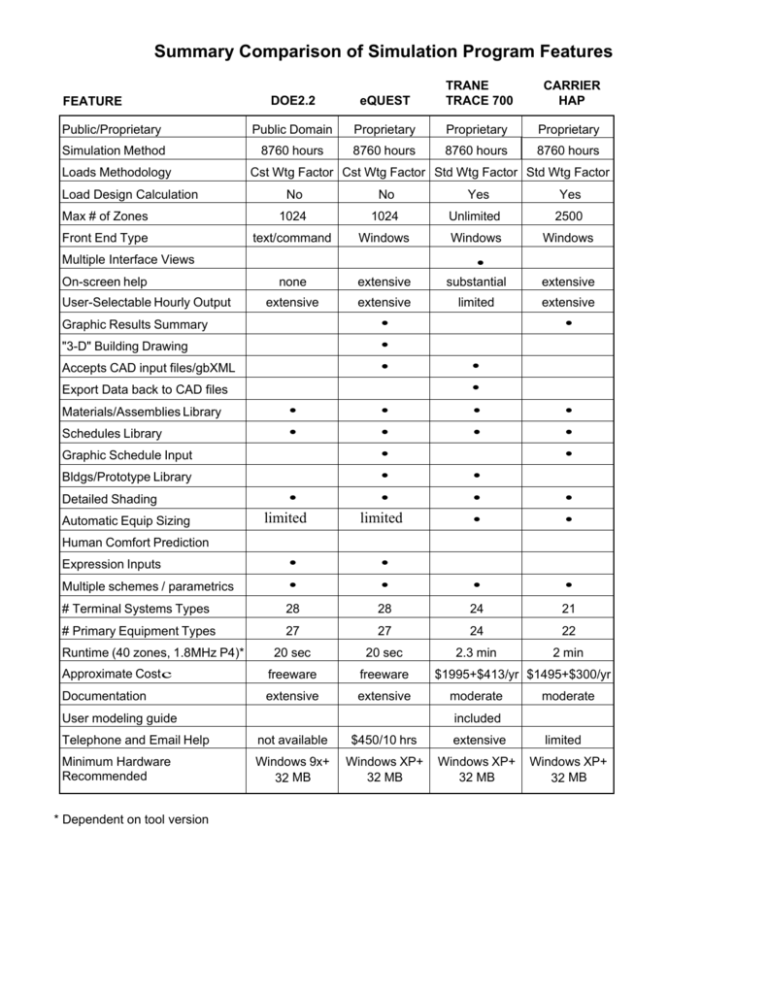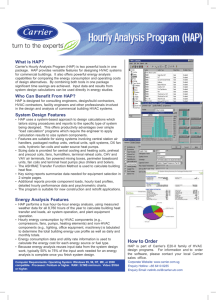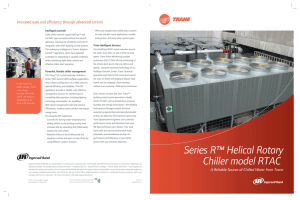Building Simulation Tool Comparison (eQUESTvsHAPvsTRACE)
advertisement

Summary Comparison of Simulation Program Features DOE2.2 eQUEST TRANE TRACE 700 CARRIER HAP Public/Proprietary Public Domain Proprietary Proprietary Proprietary Simulation Method 8760 hours 8760 hours 8760 hours 8760 hours FEATURE Loads Methodology Load Design Calculation Cst Wtg Factor Cst Wtg Factor Std Wtg Factor Std Wtg Factor No No Max # of Zones 1024 1024 Unlimited 2500 Front End Type text/command Windows Windows Windows Multiple Interface Views On-screen help User-Selectable Hourly Output none extensive substantial extensive extensive extensive limited extensive • • • "3-D" Building Drawing Accepts CAD input files/gbXML Export Data back to CAD files Schedules Library Yes • Graphic Results Summary Materials/Assemblies Library Yes • • Graphic Schedule Input • • • • • • • • • • • • • limited • • • • • Multiple schemes / parametrics • • • • • • # Terminal Systems Types 28 28 24 21 # Primary Equipment Types 27 27 24 22 20 sec 20 sec 2.3 min 2 min Approximate Costc freeware freeware Documentation extensive extensive Bldgs/Prototype Library Detailed Shading Automatic Equip Sizing • limited Human Comfort Prediction Expression Inputs Runtime (40 zones, 1.8MHz P4)* User modeling guide $1995+$413/yr $1495+$300/yr moderate included Telephone and Email Help not available $450/10 hrs extensive Minimum Hardware Recommended Windows 9x+ 32 MB Windows XP+ 32 MB Windows XP+ 32 MB * Dependent on tool version moderate limited Windows XP+ 32 MB Comparison of LOADS Modeling Capabilities DOE2.2 eQUEST TRANE CARRIER TRACE HAP Weather data 365 365 12/365 365 • • • • • • limited • • • • • • 1024 1024 No max 2500 • • • • names names names names • • • • 52 52 12 8 • • • • • • • • • • • • • • • • • • • • • • • • • • • • • • • • •* • • • • • • • • Desired illuminance (program calc's lighting power) • • • • Max Number of Lighting & Equipment Loads per Zone 5 5 unlimited Daylighting Levels Predicted on Request • • • limited limited limited Number of weather data days used Statistical weather summaries available User-processing of custom weather data Calculation Time Step 1-hour in LOADS 15 min or 30 min kW reporting Spaces and Zones Max # of Spaces / Zones Spaces used as components of HVAC zones Spaces/Zones named or numbered? Floor and/or Space multipliers Schedules Maximum number of seasons per schedule Shading Overhangs Fins Setbacks (I.e., "Reveals") Detached (e.g., adjacent building) Self-shading Shade transmittance schedulable Operable interior/exterior shading limited Glazing Systems Input Methods Simple shading coefficient & conductance Glazing library User-definable layer-by-layer specification Lighting Systems Input Methods Simple lighting power and/or density Luminaire characteristics and Count Natural Ventilation * Import from Windows 5 available 3 Comparison of Air-Side SYSTEM Modeling Capabilities TRANE CARRIER TRACE HAP DOE2.2 eQUEST • • • • • • • • • • • • • • • • • • • • • • • • • • • • • • • • • • • • • • • • • • • • • • • • • • • • • • • • • • • • • • • • • • • • • • • • • • • • • • • • • • • • • • • • • • • • • • • • • • • • • • • • • • • • • • • • Air-Side SYSTEMS Types Single Supply Duct Types Packaged single-zone system Single-zone fan system w optional sub-zone reheat Constant volume reheat fan system Single-zone inducion fan system Variable volume (VAV) fan system, optional reheat Fan-powered VAV (powered induction unit) system Packaged variable volume system Ceiling bypass variable volume system Packaged variable volume / variable temperature Packaged total gas solid desiccant system Evaporative cooling system Underfloor air distribution systems Displacement ventilation systems Active chilled beam system Passive chilled beam system Air Mixing Systems Dual duct system Dual fan dual duct system Multizone system Packaged multizone system Terminal Unit Systems Packaged terminal air conditioner Unitary hydronic ("California") heat pump system Two-pipe fan coil system Four-pipe fan coil system Two-pipe induction system Four-pipe induction system Variable refrigerant volume system Ground-source heat pump system Gas engine-driven heat pump system • Residential Systems Packaged rooftop system Split system Variable volume / variable temperature system Heating Only Systems Heating and ventilating system Unit heater Comparison of Air-Side SYSTEM Options DOE2.2 eQUEST TRANE CARRIER TRACE HAP Air-Side SYSTEMS Options Coil Sizing based on: Coincident (building block) load Non-coincident (sum of each zone) load User-input • • • • • • • • • • • • • • • • • • • • • • • • • • • • • • • • • • • • • • • • • • • • • • • • • • • • • • • • • • • • • • • • • • • • • • • • • • • • • • • • • Thermostat Action Options Two-position Proportional Reverse-acting Automatic start-up cycles Coil Control Options Constant temperature Reset by OSA Reset by zone demand User scheduled Fan Control Options Constant volume Cycling Two-speed Inlet vane Discharge dampers Variable speed drives User-definable curve Fan static pressure optimization • • • • Air-Side Economizer & Ventilation Options Dry-bulb economizer Enthalpy economizer Fixed volume VAV control Schedulable OSA quantities Indirect and direct evaporative cooling ASHRAE Standard 62.1 2004/2007 Demand control ventilation Adjacent room air transfer • • • • • Dedicated Outdoor Air Options Split dehumidification Dehumidification control Control optimization (DB and Dew Point) • • • Active Dehumidification Controls Worst case room • • • • Mixed air bypass Return air bypass Variable speed fan Heat Recovery Options • • • • • • • • • • Multiple stages available Heat pipe Solid desiccant Liquid desiccant Type III desiccant Sensible wheel Total energy wheel Coil runaround loops Fixed plate heat exchanger Fixed membrane heat exchanger Duct losses Direct, plenum, and ducted return paths CFM loss reduces air to zone Thermal & air losses affect surrounding zone temp • • • • • • • • • • • Comparison of Water-Side PLANT Equipment Modeling Capabilities TRANE CARRIER TRACE HAP DOE2.2 eQUEST • • • • • • • • • • • • • • • • • • • • • • • • • • • • • • • • • • • • • • • • • • • • • • • • • • • • • • • • • • • • • • • • • • • • • • • • • • • • • • • • • • • Water-Side PLANT Equipment Types Heating Electric HW or steam boiler Fuel HW or steam boiler Cooling 1-Stage & 2-stage HW or steam absorption chiller Direct-fired 2-stage absorption chiller Open/hermetic centrifugal chiller (water/air-cooled) Open/hermetic reciprocating (water/air-cooled) Rotary screw chiller (water/air-cooled) Double bundle chiller Engine-driven chiller Central geothermal (cascaded or fully mixed) • Heat Rejection Open cross-flow or counter-flow tower Open cross-flow or counter-flow tower with HX Ground loop Scheduled temperature (e.g., lake, aquifer) Evaporative precooling for DX systems Chiller-tower optimization • • • Thermal Storage Hot water storage Chilled water storage Ice or eutectic thermal storage Electric Generating Equipment Diesel engine Photovoltaic Modules Steam or gas turbine • Water-Side Economizer Condenser water coils for DX systems "Parallel" plate&frame or strainer cycle "Series" plate&frame Refrigerant migration Fluid cooler Load shedding • Other Purchased steam or chilled water Chilled water reset • Condenser water reset Hot gas reheat for dehumidification • • Comparison of Water-Side PLANT Options DOE2.2 TRANE eQUEST TRACE CARRIER HAP Water-Side PLANT Equipment Options Plant Equipment Sizing based on: User-defined design day weather Annual weather file data • • • • • • • • • • • • • • • • • • • • • • • • • • • • • • • • • • • • • • • • • • • • • • Heating and Cooling Equip Control Options mixed equipment types lead-lag equipment control seasonal equipment control time-of-day equipment control preferential equipment loading Cooling Tower Control Options Fixed leaving water temperature Wet-bulb reset One-speed fans Two-speed fans Variable-speed fans








